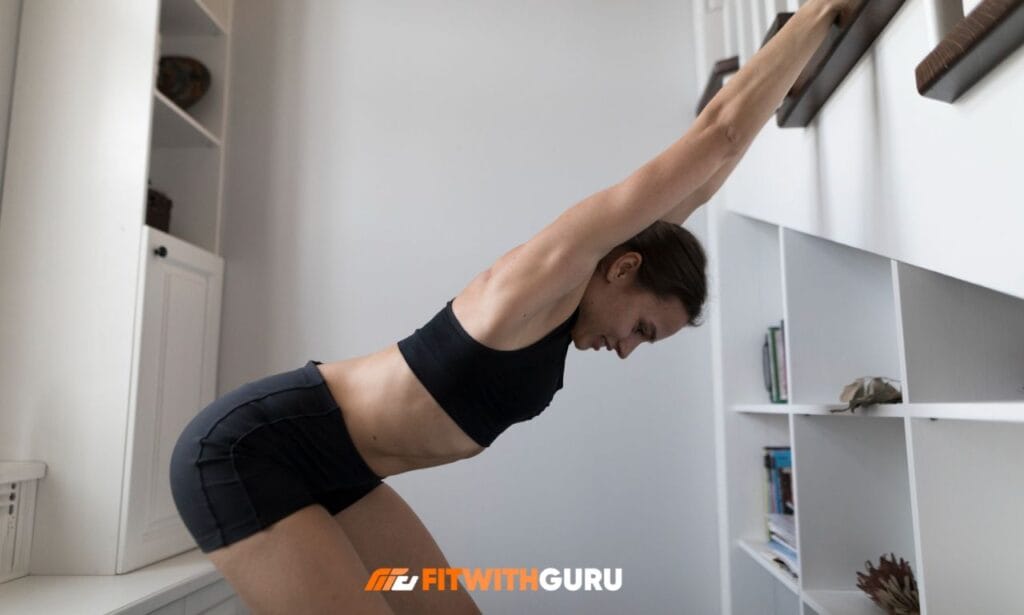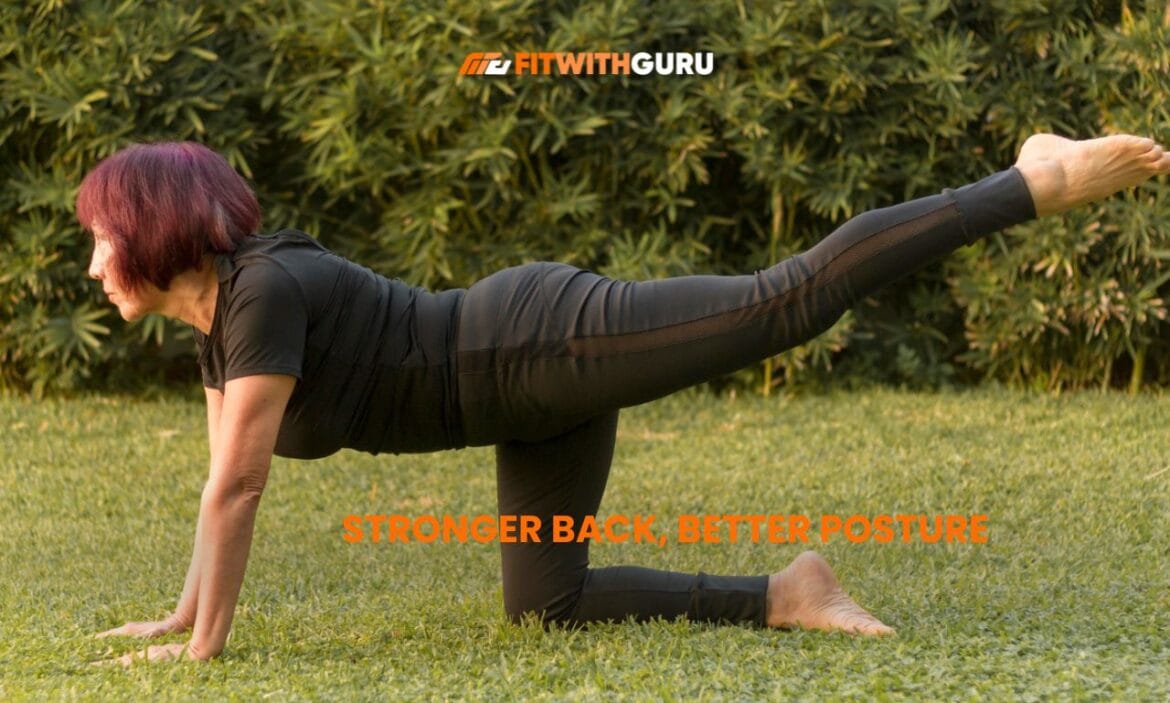Many people ignore maintaining a strong back when working towards their fitness goals, even though it is crucial for proper posture. Back pain, discomfort, and long-term health issues can result from poor posture. Whether sedentary or active, everyone needs a back bodyweight workout because it supports the spine, increases mobility, and strengthens the entire body.
The significance of back strength will be discussed in this article, along with eight efficient back bodyweight exercises that will help you avoid injuries and improve your posture. By including these exercises in your routine, you can improve your posture and develop a healthier body to handle your daily tasks.
The best thing about it? These exercises are suitable for both at-home and gym settings and don’t require any special equipment.These bodyweight exercises for the back will help you strengthen your back bodyweight workout, avoid slouching, and reap the long-term benefits of improved posture, regardless of your experience level.
Why Is a Strong Back Important for Posture?
Maintaining good posture and general health requires a strong back. This section will discuss the dangers of bad posture, how having a strong back bodyweight workout helps with posture, and how your health can be enhanced by strengthening your back muscles.
How Poor Posture Affects Your Health
Your muscles and spine are not aligned properly when you have bad posture. This misalignment can result from back pain, joint pain, and tense muscles. Inappropriate posture can even lead to long-term problems like spinal degeneration, herniated discs, and a weakening of the core. These health issues lower your quality of life and interfere with your everyday activities.
Benefits of a Strong Back for Better Posture
By stabilizing the muscles and supporting the spine, a strong back is essential for maintaining proper posture. It keeps the body aligned, lowers the chance of back pain, and helps avoid slouching.
You can carry out daily tasks more easily if your back bodyweight workout is well-developed because it increases your range of motion. Strengthening your back muscles makes a healthier lifestyle and improved posture possible.
The Role of Core Strength in Posture
While the back muscles are essential for good posture, the core muscles also play an important role. The core provides stability to the spine and helps maintain an upright position.
A strong core supports the back during movement, making it less likely for you to slouch or strain your muscles. Working on both the back and core muscles together is important to achieve optimal posture.
How to Perform a Back Bodyweight Workout for Posture
Bodyweight exercises are an effective and accessible way to strengthen your back muscles. Here, we’ll cover the best techniques and tips for performing these exercises correctly to improve posture and avoid injury.
Proper Technique for Bodyweight Back Exercises
When performing back bodyweight exercises, using the proper form to avoid strain or injury is important. Focus on controlled movements, keeping your spine neutral and avoiding excessive arching or rounding.
Engage your core throughout each exercise to provide support for your back bodyweight workout. Always perform the exercises slowly and deliberately to ensure you activate the correct muscles and maximize the benefits.
Common Mistakes to Avoid in Bodyweight Workouts
Even though bodyweight exercises require no equipment, improper form can still lead to injury. Common mistakes include overextending the back, failing to engage the core, and rushing through movements.
Make sure to start slowly, gradually increasing your intensity as you become more comfortable with each exercise. Avoid using momentum to complete the movements; focus on steady, controlled actions.
How Often Should You Do Back Bodyweight Workout?
For optimal results, performing back bodyweight workout 2-3 times per week is recommended, allowing your muscles time to recover between sessions. Ensure you also incorporate rest days and focus on other muscle groups, such as the core and legs, to maintain a balanced fitness routine. Consistency is key to improving posture and building a stronger back bodyweight workout.
8 Must-Try Back Bodyweight Exercises for Stronger Posture
This section will introduce eight effective bodyweight exercises designed to target your back muscles and enhance your posture. These exercises are simple to perform and require no equipment.
1. Superman Hold
The Superman Hold is a great exercise for strengthening the back bodyweight workout, glutes, and shoulders. To perform the Superman, lie face down with your arms above your head.
Slowly lift your arms, chest, and legs off the ground, holding the position for a few seconds before lowering. This movement helps engage the back muscles, improving spinal alignment and posture.
2. Bird-Dog Exercise
The Bird-Dog is an excellent exercise for improving core stability and strengthening the lower back. Begin on all fours with your hands beneath your shoulders and knees beneath your hips.
Extend your right arm forward and left leg backward, maintaining a straight line from head to toe. Hold the position briefly, then return to the starting position and switch sides. This exercise targets the entire back bodyweight workout and helps enhance balance and posture.

3. Reverse Snow Angels
- Reverse Snow Angels target the upper back, shoulders, and traps. Start by lying face down with your arms at your sides. Lift your arms off the ground and sweep them overhead, mimicking the motion of making snow angels.
- Keep your arms straight and focus on squeezing your shoulder blades together as you move your arms. This exercise helps open the chest and strengthen the upper back muscles, promoting better posture.
4. Glute Bridge
The Glute Bridge is a great exercise for strengthening the lower back and glutes. Begin by lying on your back with your feet flat on the ground and your knees bent. Push through your heels and lift your hips toward the ceiling, engaging your glutes and lower back.
Hold the position at the top before lowering back down. This exercise helps stabilize the pelvis and supports a stronger, more aligned back bodyweight workout.
5. Bridge March
- The Bridge March is a variation of the Glute Bridge that increases the challenge by adding leg movements.
- Start in a traditional Glute Bridge position, then slowly alternate, lifting one leg off the ground while maintaining a stable pelvis. This variation increases core and back engagement, helping to improve overall posture.

6. Prone T Raises
Prone T Raises target the upper back and shoulders, improving posture by strengthening the muscles responsible for scapular retraction. Begin by lying face down with your arms extended at a 90-degree angle to your body.
Lift your arms off the ground, squeezing your shoulder blades together as you raise them. This exercise helps improve shoulder mobility and correct rounded shoulders, contributing to poor posture.
7. YTWL Raises
- YTWL Raises are a series of movements designed to strengthen the upper back, shoulders, and traps. Begin by lying face down, arms extended overhead in a Y shape.
- Slowly raise your arms, then move them into a T shape, followed by a W, and an L shape. These movements target different back bodyweight workout parts, promoting improved posture and shoulder stability.
8. Plank to Push-Up
The Plank to Push-Up exercise targets the core, shoulders, and back. Start in a forearm plank position, then transition into a full push-up position by pressing up onto your hands one arm at a time.
Lower back down into the plank position, alternating sides. This exercise strengthens the core and back bodyweight workout while helping to improve spinal alignment.

How to Incorporate These Exercises into Your Routine
Incorporating back bodyweight exercises into your workout routine is simple. Here’s how you can design a balanced and effective workout plan.
Designing a Back Strengthening Routine
- A great back strengthening routine should include 3-4 exercises targeting different areas of the back. Start with exercises like the Superman Hold and Bird-Dog to work the lower back, then move on to Reverse Snow Angels and Prone T Raises for the upper back.
- Perform each exercise for 3-4 sets of 10-15 reps, gradually increasing the intensity as your back strengthens.
Combining Back Exercises with Other Workouts
You don’t have to focus solely on back exercises. Incorporate these back bodyweight workout movements into a full-body workout routine, pairing them with core, lower body, or upper body exercises for a well-rounded approach. For example, you can add bodyweight squats, push-ups, or lunges to complement the back exercises and keep your workouts diverse and engaging.
How Long Should Each Workout Session Last?
Aim for 20-30 minutes per workout session. This should give you enough time to perform a full back workout, with 3-4 exercises targeting various areas of the back bodyweight workout. Keep the intensity moderate and focus on quality over quantity to maximize the benefits of each exercise.
Tips for Maximizing the Effectiveness of Your Back Workouts
To get the most out of your back bodyweight workouts, it’s important to focus on these key factors.
Focus on Controlled Movements
Perform each exercise with controlled movements, avoiding the use of momentum. Focus on proper form and breathing throughout each repetition. This will help activate the right muscles and prevent injury.
Rest and Recovery
Allow your muscles time to recover by taking at least one rest day between back workouts. Recovery is essential for muscle growth and improving posture over time. Adequate sleep and stretching can also help prevent stiffness and soreness.
Nutrition for Muscle Recovery
Eat a balanced diet with enough protein, healthy fats, and complex carbs to support muscle recovery. Proper nutrition will help you build stronger back bodyweight workout muscles and improve posture faster.

FAQs
What are the best back bodyweight exercises for beginners?
Exercises like the Superman Hold, Bird-Dog, and Glute Bridge are great options for beginners. They target key back muscles and can be easily modified to fit your fitness level.
How can I improve my posture with just bodyweight exercises?
Incorporating bodyweight exercises like Reverse Snow Angels, Prone T Raises, and Glute Bridges into your routine will strengthen your back and core, promoting better posture.
How long will it take to see results from back bodyweight exercises?
Results can vary depending on consistency, but with regular practice, you can expect improvements in your posture and strength within 4-6 weeks.
Conclusion
A strong back bodyweight workout is essential for maintaining good posture and preventing back pain. Incorporating the eight bodyweight exercises we’ve covered into your workout routine will help you strengthen your back, improve your posture, and enhance your overall health.
By focusing on controlled movements, proper technique, and recovery, you can maximize the benefits of these exercises and enjoy a stronger, healthier body.

